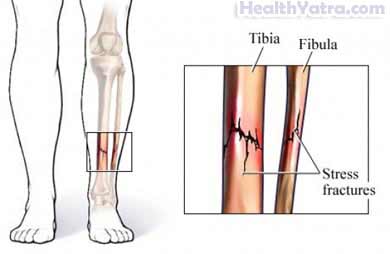Definition
A stress fracture is a tiny crack in the bone. Most stress fractures occur in the lower leg and foot. They can also occur in the hip and other areas. Most stress fractures can heal spontaneously. However, some may lead to complete fractures, or may require surgery.

Causes
A blow to the bone does not cause a stress fracture. Rather, it is typically caused by repeated stress or overuse. Some causes are:
- Increasing the amount or intensity of an activity too quickly (most common)
- Switching to a different playing or running surface
- Wearing improper or old shoes
Stress fractures can worsen by continued physical stress. Smoking can also make stress fractures worse because it interferes with bone healing.
Risk Factors
A risk factor is something that increases your chance of getting a disease or condition. Risk factors for a stress fracture include:
- Sex: female
- Certain sports, especially involving jumping or running:
- Tennis
- Track, especially distance running
- Gymnastics
- Dance
- Basketball
- Amenorrhea (women only)
- Reduced bone thickness or density
- Poor muscle strength or flexibility
- Overweight or underweight
- Poor physical condition
Symptoms
Symptoms include:
- Localized pain on the bone
- Pain when pressure is applied directly over the fracture and the area around it
- Pain when putting stress on the affected leg
- Swelling and warmth at injury site
Diagnosis
The doctor will ask about your symptoms and medical history, and examine the injured area for localized pain and swelling.
Tests may include:
- X-ray—a test that uses radiation to take pictures of structures inside the body, especially bone
- Stress fractures are very tiny and usually not seen on an x-ray until at least two weeks after symptoms begin.
- MRI scan—a test that uses magnetic waves to show swelling and inflammation inside the bone
- Bone scan—a test that uses a short-lived radioactive substance to show a stress fracture
Treatment
Treatment includes:
Medications
Nonsteroidal anti-inflammatory drugs (NSAIDs) can relieve pain, but controversy exists about their use for stress fractures. It is possible that NSAIDs adversely affect stress fracture healing.
Rest
Rest is the most important thing you can do for a stress fracture. This includes avoiding the activity that caused the fracture and any other activities that cause pain. Rest time required is at least 6-8 weeks.
Crutches or a Cane
You may need crutches or a walking cane to keep pressure off the leg.
Activity
Talk with your doctor about when you can restart activity and how to progress with the amount and type of activity.
A common progression:
- Begin with nonweight–bearing activities, such as swimming or bicycling.
- Next, you can do weight-bearing, nonimpact exercise, such as a stair machine.
- Gradually, you will be able to add low-impact activity, starting with walking.
- Once you can do fast-paced walking with no pain, you can start higher impact activity, such as light jogging.
- This gradual progression continues until you have reached your pre-injury activity level. You can return to full activity once you do not feel tenderness of the bone.
Prevention
To reduce your chance of getting a stress fracture:
- Wear proper footwear.
- Run on a softer surface, such as grass, dirt, or certain outdoor tracks.
- Gradually increase the amount and intensity of an activity.
- Do not overdo any activity.
- Eat a healthful diet, including foods rich in calcium and vitamin D.
- Avoid smoking.
